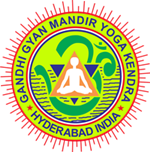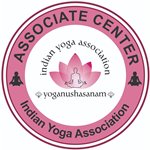These asanas are useful for the people of all ages.
- 1. Shanti asan – Shavasan – Peace asan or Corpse asan
- 2. Supta Pavan muktasan
- 3. Tanasan
- 4. Anantasan or Krishnasan
- 5. Balasan
- 6. Uttan-padasan or Padottanasan
- 7. Pad-chalanasan
- 8. Naukasan
- 9. Supta Matsyendrasan
- 10. Supta Merudandasan (Set of various asanas)
- 11. Setubandhasan
- 12. Sarvangasan
- 13. Padma-sarvangasan or Urdhva padmasan
- 14. Halasan
- 15. Karna-peedasan
- 16. Chakrasan
- 17. Supta Chakki chalan Kriya
1. Shanti asan – Shavasan – Peace asan or Corpse asan:
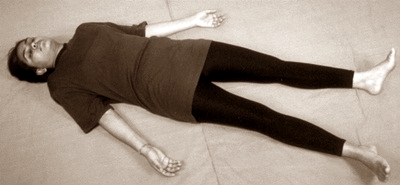
In this asan the body and mind are at ease and calm, therefore it is called Shanti asan (Peace asan).
Procedure:
Lie down on the back with palms upwards, spread the legs little apart and let loose all the parts of the body. There should be no tense anywhere in any part of the body.
Stages:
I. Respiration in this asan is normal and in natural process. The stomach movement, during respiration is like that of an infant. While breathing in, the stomach is gradually bulged up and when breathed out completely, the stomach is totally pressed down. The body in this condition is totally at rest.
II. After totally resting for few minutes in the above position, the body is slowly turned to right side, resting the head on the folded right hand, placing the left hand on the left thigh. The entire body is straight. The breathing is normal. During this position the body and mind are quiet peaceful. Breathing becomes more prominent through left nostril (Chandra Swar).
III. Now the body is slowly turned to left side, left hand is folded and placed under the head as a pillow. The entire body is kept straight. The right hand is placed on the right thigh. The breathing become more prominent through the right nostril (Surya Swar).
Entire body is physically loose and mentally hollow during all the above three stages of the Shanti asan.
Awareness:
Relaxation in the whole body
Advantages:
All the parts of the body become calm. You will get rid of tiresomeness and fatigue (mental tiredness). Tension is reduced. The total body is relaxed and re-energized. During Yoga practice, this asan gives required relaxation from time to time.
“Shanti asan for total relaxation and tranquility”
2. Supta Pavan muktasan:
Pavan means air. The air that is in the stomach (apaan vayu) is impure. Mukti means to get rid of. Pavan muktasan means the asan through which the stomach gets rid of impure air present in it. This asan is to be performed in the bed itself, as soon as we get up in the morning. The gas that is produced during the digestion of night meal remains in the stomach only. That gas is let out through this asan. This asan can be practiced at other time also.
Procedure:
Lie on the back with the legs stretched. Keep the left leg straight. Bend the right knee and hold it with both the hands. Press the knee towards the stomach. Breathing out raise the head and touch the knee with the chin. Later, breathing in stretch the leg straight. Repeat the same with the left knee in the second stage.
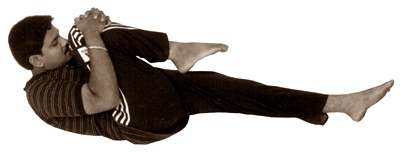
Later in the third stage, lift both the knees and bend them,hold them with both the hands. Raise the head and breathing out touch the knees with the chin. Swing entire body front and back 5 to 10 times in this position. Then swing left to right and right to left 5 to 10 times. The three stages form one round. Three to four such rounds are to be practiced.
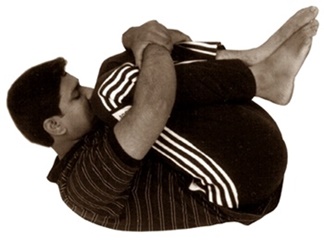
Awareness:
Abdominal area
Advantages:
Pavan muktasan sends out the impure gas out of the body. It solves the problem of constipation and keeps the stomach clean. Fat content in the body is reduced and so obesity is gradually minimized. Backbone is strengthened. Lungs function properly. Pain in knees is relieved.
Note: Pregnants should not attempt this asan. All others can practice it.
“Supta Pavan muktasan to eliminate the unwanted gases”
3. Tanasan:

Getting up after a sleep, pet animals stretch and elongate their bodies to get rid of laziness. Men also stretch their bodies to get rid of tiresomeness and laziness. If we stretch the body in the morning, the tiredness and the laziness of the night is relieved.
Procedure:
Lie on the back, stretch hands and legs to their maximum. The body should be in the stretched position for 10 to 20 seconds. Gradually relax. This act should be repeated 4 to 5 times. Breathing is normal during this exercise.
In the second stage, stretch the right arm and right leg only for few seconds. After that repeat the same on the left side only. Repeat 3-4 times alternately.
Awareness:
Stretch in the body
Advantages:
All the nerves of the body are stretched in this exercise. Every nerve is energized and strengthened. The body is relieved of laziness and tiredness.
“Tanasan to eliminate lethargy”
4. Anantasan or Krishnasan:
This asan was favourite of Lord Shri Krishna.
Procedure:
1. Lie in Shanti asan posture. Turn right, raise the head and place it on the palm. Raise the left leg and hold the ankle with the left hand raising to 90 degrees. Move the foot up and down 8-10 times.
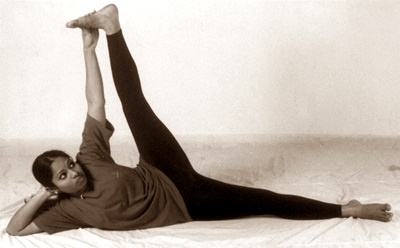
2. Being in the above position, place left hand under the left knee and fold the leg at knee up and down for 8-10 times.
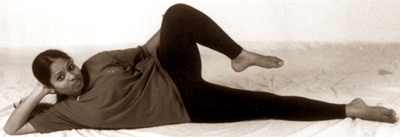
3. Place the left hand on the floor near the chest. Raise the left leg up completely and lower down for 8-10 times.
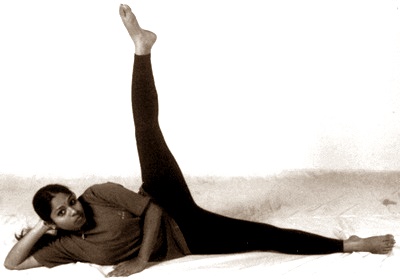
4. Similarly raise both the legs together and bring down for 8-10 times.
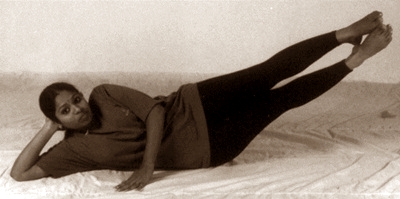
Repeat the above on the other side. Breathing is normal throughout.
Awareness:
1. Calf muscle, 2. Knees, 3. Thigh, 4. Waist (of the raised side)
Advantages:
Calves, knees, thighs, legs and leg joints are strengthened.
“Anantasan to strengthen the thigh joints”
5. Balasan:
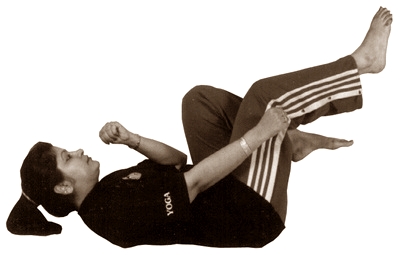
Infants (Bal) posture Balasan naturally and so this name. Any machine that is kept unused for a long time, it gets rusted and does not function properly. Similarly if there is no proper movement to the parts of our body, they become weak and inactive. Asans like Balasan give sufficient movement to the different parts of the body.
Procedure:
Lying on the back, move the legs and hands as one paddles a bicycle, simultaneously move the head left and right. After doing so for a minute, do it in reverse. Breathing is normal.
Awareness:
Movement of the body
Advantages:
The infant exercises this action on its own, without any ones help and get its blood circulation regulated. Similarly Yoga practitioners by doing this exercise can regulate their blood circulation properly and get their hand and leg joints function smoothly.
“Balasan for the proper blood circulation in the entire body”
6. Uttan-padasan or Padottanasan:
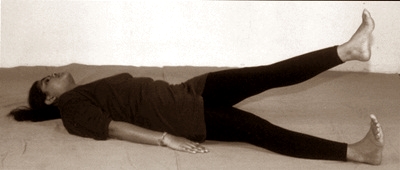
This asan is done by raising the leg so it is called Uttan-padasan.
Procedure:
Lying on the back, stretch the legs straight. Place the hands at the side with palms touching the floor. Head and neck are also rested on the floor.
Raising the right leg to about one foot above the floor, take a deep breath. Bring it down breathing out. Knees should not bend.
Repeat the same action with the left leg.
Later, raise both the legs simultaneously breathing in and bring them down breathing out. It is one round. One has to practice three to four such rounds. During this asan legs are to be raised and lowered gradually and slowly. Keep the eyes closed throughout.
Awareness:
Raised leg
Advantages:
This asan reduces the gas. Hernia is controlled. The fat in the stomach is reduced and thereby the appetite is increased. Many stomach diseases are controlled. Waist and back pains are cured. As blood flows towards heart directly in this exercise, the functioning of the heart becomes natural and efficient. This asan also helps in keeping the navel in its proper place.
“Uttan-padasan to strengthen the legs and the stomach”
7. Pad-chalanasan:

As the leg is rotated in this exercise, so it is termed as padchalanasan.
Procedure:
Lying on back, keep the palms on the floor. Lift right leg completely up (i.e. thigh, foreleg and the foot) and rotate in a circular form clockwise 5 to 6 times slowly. Later rotate in the reverse direction equal number of times.
Repeat the same with the left leg. After that, raise both the legs together and rotate as above. Breathing is normal in this exercise. Knees should not bend.
Awareness:
The movement of the legs
Advantages:
Apart from all the advantages of Padottansan as in No.6, the thigh joints are energized.
“Pad-chalan asan to empower the thigh joints”
8. Naukasan:
Nauka means a boat. The body is posed like a boat in this exercise, so it is termed as Naukasan.
Procedure:
Lying on the back, stretch the legs and hands. Join both the hands in the namaskar position. Breathing in lift the arms and legs one foot above the floor. Breathing out bring the hands and the legs to their normal down position.

In second stage, the same exercise is repeated with the palms resting on thighs.
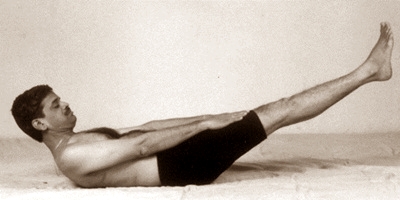
In third stage, stretch both the hands and legs apart. Breathing in, raise both the hands, leg and the head one foot high. Breathing out slowly come down.
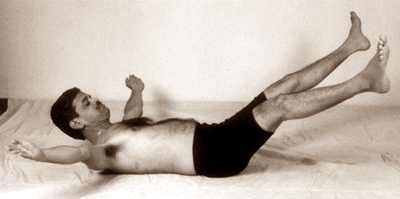
Repeat each stage 2–4 times.
Awareness:
Navel, in the middle of abdomen
Advantages:
Naukasan helps a lot to strengthen navel. Stool is excreted easily and quickly. Gas in the stomach is relieved. Waist pains are prevented. Hernia is controlled. Stomach problems are eliminated.
“Naukasan to strengthen the navel”
9. Supta Matsyendrasan:
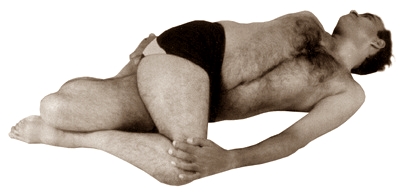
This asan is named after great Yogi Matsyendranath and is popular by that name.
This asan is also practiced in sitting position. The simple method of practicing this asan in the lying position is Supta Matsyendrasan.
Procedure:
Lying on the back, keep the legs together. Now raise the right leg and place it by the side of the left knee. Hold the right knee with left hand. Now fold the left knee and hold the left toe by the right hand. Breathing out tilt the right knee to left side till it touches the ground. Turn the head to the right side. After few seconds, breathing in, lift the right knee up. This action is done 5 to 6 times.
Similarly, repeat the same action on the other side by changing the legs and hands.
Awareness:
Abdomen / Waist
Advantages:
Liver, spleen, kidneys, pancreas, shukrashayas..are empowered. The fat in the stomach and hips is reduced. Pains in knees and neck are cured. This exercise helps a lot in arresting sugar disease i.e. diabetes.
“Supta matsyendrasan the best treatment for diabetes”
10. Supta Merudandasan (Set of various asanas)
Merudand means the spine (back bone). This asan is concerned to back bone, so it got its name as Merudandasan.
This set of asanas can be performed by lying on the back bone. If any one can’t, he or she may do it everyday in the sitting position also. These asanas can be done alternatively one day in the lying position and another day in the sitting position.
Each of the exercises of this set can be repeated 5 to 10 times depending on ones capacity and patience.
In each of the exercise whenever the body is turned on side, breath should be exhaled and whenever the body comes to normal central position the breath is inhaled.
The following exercises are done one after the other in a sequence.
Procedure:
1. Lying on the back with legs together straight, stretch both the hands sidewise. Raise the right hand and place it on the left palm joining both the palms in the namaskar posture. Later bring right hand back to right side. Similarly, place the left hand on the right palm. The backbone is twisted to left and right sides alternatively.
Awareness:
Backbone – upper part and neck
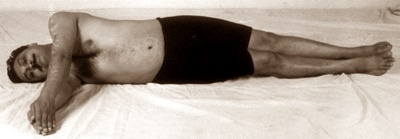
2. Stretch both the hands sidewise. Join both the heels. Turn waist, left hip and central part of the body to the right and the head to the left without raising either hands or shoulders. Later come back to central position. Similarly repeat on the other side.
Awareness:
Backbone – upper part
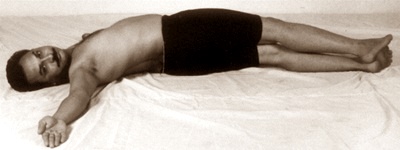
3a. Stretch both the hands side wise, slowly place the right foot on the left foot across joining the little toes of both the feet. The above exercise No. 2 is repeated.
3b. Place the left foot on the right foot across joining both the little toes and repeat the exercise under 3a.
Awareness:
Backbone – Central part
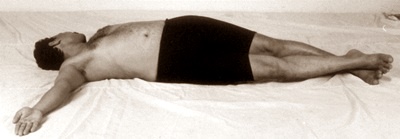
4a. Stretch both the hands sidewise. Place the right heel on the toes of the left foot. Practice as in 3a.
4b. Place the left heel on the toes of the right leg and repeat the exercise as under 4a.
Awareness:
Backbone – lower part
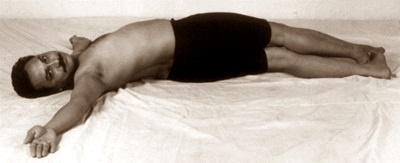
5a. Stretch both the hands sidewise. Place the right sole on the left knee. Slowly bend the right knee leftward and touch the floor. Turn the head towards right and look at the right hand fingers. Bringing the knee up and slowly turn the right knee rightward touching the floor looking at the left hand.
5b. Repeat as in 5a changing the legs.
Awareness:
Waist and thighs
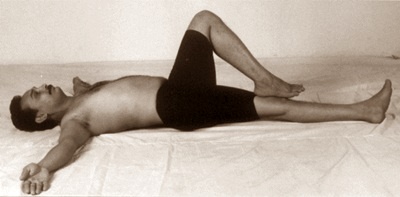
6a. Stretch both the hands sidewise. Bend the knees and let both the heels come near the hips, so that hips are touched by the heels. Join both the knees and heels together. Turn both the knees right and touch the floor by the knees. Turn the head towards left looking towards left hand fingers. Later coming to the normal central position, repeat the exercise on other side also by bending the knees left side and looking at the right hand fingers.
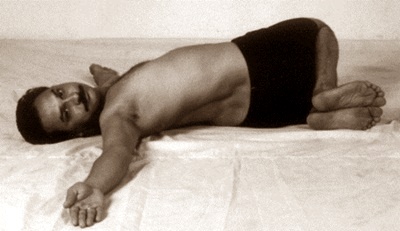
6b. Keeping the position as in 6a, now bend both the knees towards the stomach. Repeat as in 6a. While bending on side let the knee touch the elbow.
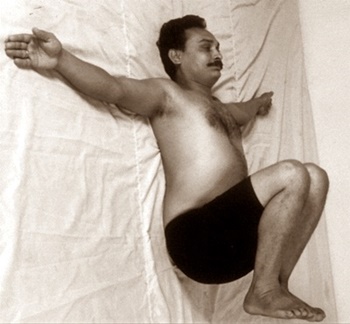
6c. From position 6a now tilt both the knees on both the sides and move the knees up and down.
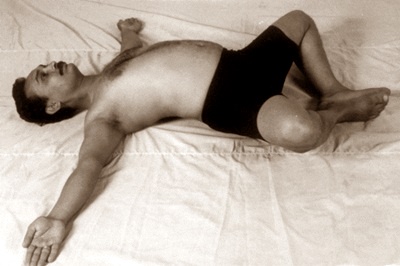
Awareness:
Lower back / Thigh joints
7. Stretch both the hands sidewise. Bend both the knees and place the heels near the hips, keeping one-foot distance between the heels. Now turn both the knees right and touch the floor with both knees, looking towards left side. Repeat the same on other side.
Awareness:
Waist
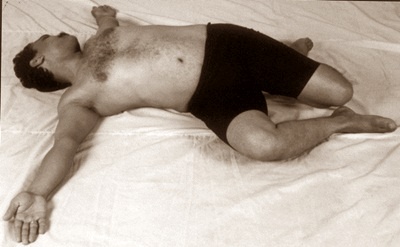
8. Stretch both the hands sidewise and legs straight. Lift the right leg up and lower it at left side resting on the floor touching the left hand. Turn the head right side. Later coming into the central position, repeat with left leg also.
Awareness:
Thighs – calves
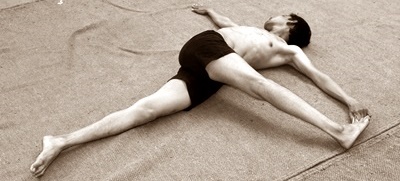
9. Stretch both the hands sidewise. Join the legs and raise them together up. Slowly turn the legs on right side and lower to the ground near to the stretched right hand. Turn the head on left side. Coming to normal central position, repeat on other side also.
Awareness:
Waist – thighs – legs
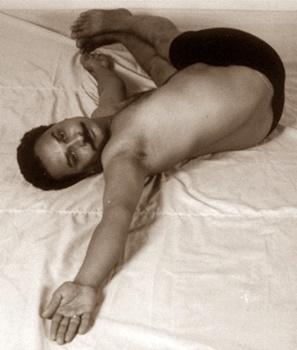
Advantages:
Back bone is strengthened. All the back bone problems are solved. It helps in empowering and stimulating the power of Kundalini. Merudandasan is proved to be very useful in relieving the waist pains, neck pains and spondylitis. These asanas also help in making all the internal parts of the stomach function properly and regularly. They especially help to control urinary problems including bed-wetting. This is the synthesis of many wonderful asanas.
“Merudandasan to empower and energize the back bone wonderfully”
11. Setubandhasan:
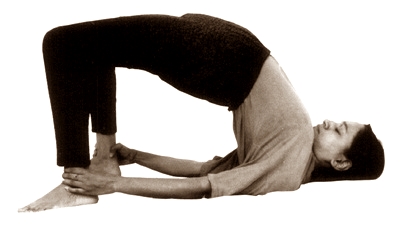
The body is turned like a bridge (=Setu) in this asan. So it is called Setubandhasan.
Procedure:
Lying on the backbone stretch both the legs straight. Now folding the knees bring the heels near to the body. Hold the ankles by the hands. Floor is forecefully pressed by 1. feet, 2. shoulders, and 3. the head. Breathing in slowly, raise a. thighs, b. waist, c. stomach and d. chest. After keeping the body for some time in this bridge position, breathing out gradually bring the body down to the floor, very slowly.
After doing this exercise two to three times, slowly move the raised body 5 to 6 times left to right and right to left.
Awareness:
Lower back
Advantages:
Back bone, waist, thighs and the calves are strengthened and energised.
“Setubandhasan to strengthen the lower back”
12. Sarvangasan:
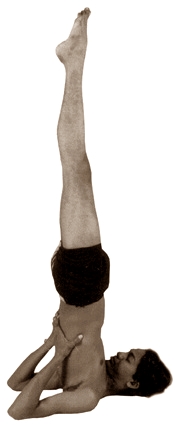
It is useful for all the parts of the body, hence it is called Sarvangasan.
Procedure:
This asan is practiced in sequence of 5 stages. Lying on back bone stretch the legs straight.
1. Fold the knees so that the heels touch the hips.
2. Lift and bend both the knees towards the stomach.
3. Giving a little jerk, lift the hips holding the waist with both the hands. Shoulders and the head rest on the floor.
4. Now straighten both the legs up. This is the crucial and final position in Sarvangasan.
5.a. Being in the final upper postition, maintaining the balance, move both the legs apart side wise and again bringing together.
b. Being in the same final position, raise one leg up and the other lower down alternatively.
c. Being in the same final position, move the legs as if they are paddling a bicycle.
The above actions of 5a, b and c are repeated 5 to 10 times each.
Breathing normally in the natural course, keep the eyes closed. After two minutes, come back down in the reverse order 4, 3, 2 and 1 in the lying position. Take sufficient rest. Maintain the balance of the body and mind throughout.
Awareness:
Whole body and its movement
Advantages:
It is a very useful asan. Men, women, children, aged, everyone can do this asan. Brain, lungs and heart are strengthened, blood is purified. Eyes, ear and mouth problems are solved. Digestive power increases. Unwanted fat desolves. The nerves of the brain and neck are energized. Weakness of the mind is summoned and the power of memory is increased. This asan is very useful for the students.
The importance of the asan: Generally head is up and legs are down. But in this asan, the head is at the bottom and the legs are stretched upwards straight. Quite reverse. So pure blood is circulated with natural force towards the head. (In normal course the blood is pumped up to the head.)
Note: After this asan, one should compulsorily take rest and then do the Matsyasan and/or Bhujangasan.
Prohibition:
People suffering from high blood pressure, pregnant women, heart patients, those whose ears constantly ooze the dirt, suffering from severe cold-neck pain-spondylitis should not attempt this asan. After getting relieved of above problems, this asan can be practiced.
“Sarvangasan to empower the whole body”
13. Padma-sarvangasan or Urdhva padmasan:
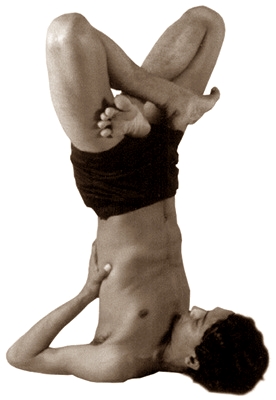
It is the combined posture of Sarvangasan and Padmasan, so it is called Padma-sarvangasan.
Procedure:
This is the extension of Sarvangasan. Being in the Sarvangasan fold legs from knees to form the Padmasan posture. While practicing Sarvangasan, this change is brought in the middle of the exercise. Later unfold the Padmasan and the body in the Sarvangasan, followed by rest in Shanti asan. Maintain the balance so that you do not fall down.
Awareness:
Whole body
Advantages:
All the advantages of Sarvangasan and Padmasan (that is practiced in the sitting position) are there in this asan. The unsteadiness of the body and the mind is relieved. Peace and calmness is restored.
Prohibition:
People suffering from high blood pressure, heart problems, neck pain, spondilitis, obesity and Pregnants are advised not to attempt this asan till they are relieved of their problems.
“Padma sarvangasan for calmness to body and peace to mind”
14. Halasan:
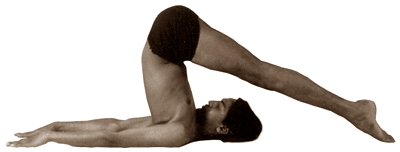
The body is turned like a plough in this asan, so it is called Halasan. Hal means plough. This is practiced after Sarvangasan. It being a difficult asan, should be practiced with great care.
Procedure:
From Sarvangasan (No. 12) fold the body at waist and crossing the head, let the toes touch the floor. Hands are stretched straight on the floor. Breathing is normal in the natural course. Keeping the body in Halasan for two minutes, later come back to Sarvangasan and again back to normal down position of Shanti asan to rest for some time, followed by either Matsyasan or Chakrasan or Bhujangasan.
Awareness:
Whole body
Advantages:
This asan has been proved very useful for the people suffering from thyroid defects, diabetes and hernia. It is also useful for the women, who have not become pregnant. It activates the uterus. It cures stomach problems. It strengthens the backbone, hips and waist. All the glands in the body are activated to function effectively.
Prohibition:
People suffering from high blood pressure, heart diseases, pus oozing from ears, severe cold and cough, neck pain, spondilitis are warned not to attempt this asan.
“Halasan to activate all the glands of the body”
15. Karna-peedasan:
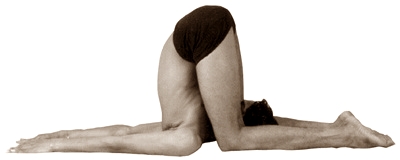
Ears are pressed in this asan, so it is known as Karna peedasan.
Procedure:
Being in the Halasan (as in no.14) bend both the knees and place them on the floor. Both the ears are pressed with both the knees. After staying so for some time, come slowly into Halasan and Sarvangasan and back to Shanti asan for rest.
Awareness:
Ears
Advantages:
Apart from all the benefits of Sarvangasan and Halasan, all the problems of the ears are controlled. Deafness is also cured.
Prohibition:
All the prohibitions of Halasan are applicable in this asan also.
“Karna-peedasan to relieve all the ear troubles”
16. Chakrasan:
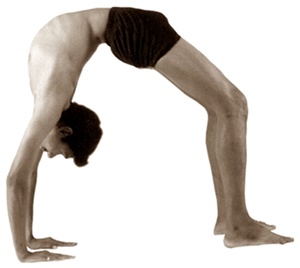
The body is turned round like a wheel (=chakra) in this asan, so it is called Chakrasan.
Procedure:
Lying on the backbone straight, bend both the knees and bring the heels near to the buttocks. Bending both the elbows, place both the palms near the ears, fingers touching the shoulders. Pressing firmly the floor with the feet and the palms, breathing in, lift the entire body up round. After being in that position for some time, breathing out slowly come down. Repeat 3 to 4 times.
Awareness:
Backbone
Advantages:
It influences the backbone and stomach. Generally the body bends forward but in this Chakrasan the body is bent backward, so it energises the backbone, stomach, lungs, legs and hands. The problems of uterus in women are solved. Blood circulation is thoroughly regulated in the brain. Headache vanishes. Shivering in the legs and hands is also cured. This asan helps a lot in strengthening ‘The youth’ in young men and women.
Prohibition:
People suffering from heart trouble, high blood pressure, weakness in the hands are warned not to attempt this asan. Persons with over weight must carefully attempt it.
“Chakrasan to strengthen and energize the hands and the waist”
17. Supta Chakki chalan Kriya:
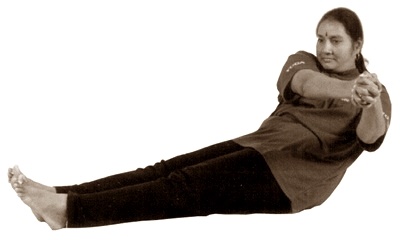
Hands are moved as they move while flouring the wheat or jawar on a normal chakki (Indian grinder), in this asan, so it is popular with that name.
Procedure:
Lying on the back, stretch the hands and legs straight. Interlock the fingers. Now getting up from waist, start circular rotation of your hands, so that in every round the fingers touch the toes breathing out. After 4 to 6 rounds, rotate in reverse direction. Neither elbows nor the knees should be bent.
If anyone cannot move the body with the stretched legs due to weakness, he or she can exercise this asan in sitting position.
Awareness:
Abdomen / rotation
Advantages:
Neck and waist are strengthened. Digestive power is increased. Constipation is eliminated. The nerves of the legs are energized.
“Supta Chakki chalan Kriya to develop the digestive power”
![]()
These are certain easy exercises that can be practiced by lying on the back position. The sadhaks may get benefits from practicing them according to one’s might and capacity.
![]()
